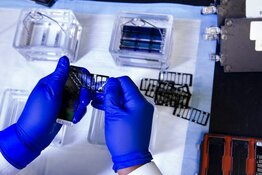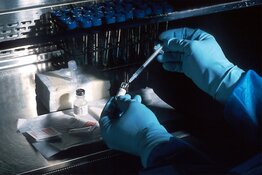The Life Sciences Report: Vernon, how do you pick investor entry points for the life science firms that you cover for MLV & Co.?
Vernon Bernardino: It all comes down to evaluating and then articulating whether a company's stock is still a compelling value. Let's use my newest report on NeoStem Inc. (NBS:NASDAQ) as an example of how a stock is evaluated. I previously put a lofty price target on NeoStem: Other analysts followed, and the company's stock performed very well. When I initiated coverage on NeoStem on Sept. 11, 2013, it was up almost 100% from its May lows, and up 70% since January. The stock rose to 52-week highs shortly thereafter, then slid after disappointing data was released from CADUCEUS, a study using autologous stem cells (SCs)—like SCs being tested by NeoStem—as a heart attack treatment, in the Sept. 17, 2013, online issue of the Journal of the American College of Cardiology.
In looking to see if NeoStem was a good bargain in the wake of the slide, I pointed to the sum-of-the-parts valuation approach I used in my initiation-of-coverage report, which derived a $16 price target. The approach applies because NeoStem has many different lines of business, some stronger than others. The stock remains a long-term play, but should positive results come in from a top-line readout with its lead product, AMR-001, there could be substantial upside to our current target price of $16 to $22.
TLSR: What is NeoStem's AMR-001?
VB: AMR-001 is the company's flagship product candidate. It is a cell-based product derived from bone marrow stem cells, enriched with a genetic marker called CD34+/CXCR4+ that is relevant to ischemic cardiovascular disease conditions, such as heart attack.
TLSR: What makes that marker valuable?
VB: It is very difficult for anyone to obtain intellectual property (IP) rights on bone marrow stem cells because they have been studied so extensively in many patients. For example, more than 1 million (1M) people have received bone marrow and blood stem cell transplants over the last 50 years or so. But NeoStem was able to obtain IP status with a bone marrow stem cell-based strategy to repair damaged heart muscle that uses the CD34+/CXCR4+ marker. That means other firms cannot copy NeoStem's specific stem cell therapy, making it more commercially viable.
TLSR: What was the nature of the non-NeoStem study that impacted NeoStem's shares?
VB: The CADUCEUS trial, conducted at the Cedars-Sinai Heart Institute in Los Angeles, used a similar approach to NeoStem's study regime, but it did not use NeoStem's AMR-001 product. The CADUCEUS study isolated, cultured and prepared stem cells derived from heart biopsies, known as cardiosphere-derived stem cells (CDSCs), as a treatment for heart attack. The CDSCs were then injected back into the patient's heart to elicit heart repair and improve heart function. Treatment with CDSCs did result in improved heart function, which is similar to results observed in many other stem cell studies. However, the stem cells studied in CADUCEUS did not result in repair of heart muscle, which was a central thesis with using stem cells for treating heart attacks.
"A forward-looking firm deploys its cash to create value by advancing the science of its lead product."
Some investors jumped to the conclusion that NeoStem's phase 2 study for AMR-001 would also not show repair of heart muscle. But it is expected that NeoStem's phase 2 study will actually confirm the company's phase 1 study for AMR-001, which demonstrated a heart muscle repair signal. The study is called PreSERVE AMI: It is due to complete enrollment by year-end, and due for a top-line readout of cardiac function and other measures in H1/14.
TLSR: Do you cover biotechs in the autoimmune and anti-inflammatory spaces?
VB: I cover Dynavax Technologies Corp. (DVAX:NASDAQ), which has experienced some mixed study results for its hepatitis B vaccine, Heplisav. In our opinion, Dynavax's technology and approach is rather advanced, and it is the scientific status quo that needs to catch up to Heplisav.
Dynavax's stock has suffered, however, because not much is known about the patient population that it studied in looking for effects of its immune-stimulating approach. But the company is well aware of the issues it needs to address with the U.S. Food and Drug Administration (FDA). The FDA seems to think the vaccine works, but further data points are needed, including safety data. The vaccine has only been tested in 2,000 or so patients in a clinical setting, so the safety data is not yet comparable to similar treatments.
TLSR: Heplisav also has an application to asthma?
VB: Yes. Asthma is associated with inflamed airways. In fact, the asthmatic's inflammatory response is most often an immune system overreaction. An asthma vaccine would putatively turn on the signal that dampens the inflammatory response. However, Heplisav's application to asthma is secondary to its hepatitis B application, and requires further study.
TLSR: How are Dynavax's financial fundamentals looking?
VB: At the end of June, the company reported it had about $105M in cash, but is likely to maintain a high burn rate because it is conducting an additional study that is expected to generate additional safety data. The additional data will accompany the safety data observed in clinical studies conducted in 2,000 hepatitis B patients so far. Generating safety data will cost a fair amount of money, and it is uncertain whether Dynavax will need to raise that money immediately. We believe that the company has enough cash on hand to get to the end of next year, but obviously, since these required studies are expensive, Dynavax will need to raise money again in the next six to nine months.
TLSR: What are the prospects for Dynavax acquiring a partner?
VB: Dynavax has publicly acknowledged having discussions with possible partners. However, any deals are pending the arrival of more safety information. The immunotherapy approach is, in many ways, unproven. The recent failure of Vical Inc.'s (VICL:NASDAQ) Allovectin, a cancer immunotherapy, for example, shows that the vaccine approach to melanoma has high potential for failure. Part of the problem is the basic science, which is still relatively early in development, but also the scientific knowledge needed to improve the process of selecting the correct patients to include in these types of studies.
TLSR: Can you talk about the importance of having scientists on the management team in a biotech firm?
VB: John Yu is a good example of the importance of having a scientist as a company's initial chief executive. Yu founded ImmunoCellular Therapeutics Ltd. (IMUC:OTCBB). And because he is a neurologist, he is able to explain the science at every level to investors.
"The winners are likely to be companies with a scientist at the helm and management that understands that funding follows good science, not necessarily vice versa."
Biotech investors can be very sophisticated. Many have MBAs, as well as PhDs and/or MDs. Yu can talk to them in technical language about why ImmunoCellular's cancer vaccine is a next-generation approach with a good chance of succeeding as a treatment. Of course, a biotech company rises or falls depending on how it manages cash burn rates. If a firm runs out of money, it does not matter how strong the science is. A forward-looking firm deploys its cash to create value by advancing the science of its lead product.
TLSR: What products does ImmunoCellular have in the pipeline?
VB: Its lead product is ICT-107, which is a dendritic cell vaccine similar to Dendreon Corp.'s (DNDN:NASDAQ) recently approved Provenge, for treating prostate cancer. Like Provenge, ImmunoCellular's dendritic cells are isolated from the patient, cultured with antigens highly expressed in cancer cells and then given back to the patient. In this case, the vaccine is targeted to glioblastoma multiforme in newly diagnosed patients. The phase 1 studies were very impressive. In fact, quite a number of those patients are still alive, although they're not followed by the company any longer.
The phase 2 trial is designed with a randomized control arm, which means it could be used for the final approval study. ImmunoCellular has, nonetheless, decided to conduct a phase 3 study. But if the phase 2 results are really positive, it would then be unethical for ImmunoCellular to do a phase 3 study that includes placebos. The company also has ICT-121 and ICT-140, which, like ICT-107, are autologous dendritic cell-based vaccines targeting cancer, but are still early stage. We currently rate ImmunoCellular as a Buy with a $6 price target.
TLSR: How did you arrive at the target price?
VB: Our valuation methodology for ImmunoCellular used a mathematical formula that factors in a product's potential to drive future earnings but changes depending on study release dates, discounts and comparable company valuations.
TSLR: What other companies do you like for stem cells?
VB: Aastrom Biosciences Inc. (ASTM:NASDAQ) has developed a stem cell product to treat dilated cardiomyopathy (DCM), a condition where the heart becomes enlarged. The patient has not necessarily had a heart attack, but is experiencing conditions that can lead to ischemia as a result of blockages in the arteries. That condition forces the heart to work harder and, therefore, grow larger. Over the long term, the enlargement can result in heart failure, because blood cannot adequately supply newly enlarged areas due to blocked arteries.
TLSR: How does this specific product work to retard heart growth?
VB: The mechanism of action through which Aastrom's stem cell drug improves heart function and elicits muscle repair is still unclear, but a growing body of evidence shows that some of these stem cells can acquire the properties of the preexisting heart cells. They can replace the damaged or non-functioning heart cells.
"Firms that can achieve initial economies of scale, whether or not the products have been proven to work, will continue to lead the pack in attracting investors."
It is also becoming widely accepted that there is a related paracrine, or hormonal mechanism of action, whereby cytokines (signaling molecules) and other factors are produced. These actions can help to improve the cardiac repair process because they promote blood vessel growth and limit inflammation. That is important, because runaway inflammation can result in a lot of scarring. Where such fibrosis occurs, muscles can no longer function optimally. We have a Hold on Aastrom with a $0.75 target.
TLSR: Your investment bank is involved in underwriting Galena Biopharma Inc. (GALE:NASDAQ). What's interesting about Galena?
VB: Galena is in a phase 3 clinical trial with a vaccine called NeuVax (nelipepimut-S), which targets underserved breast cancer patient populations. Obviously, when a breast cancer patient is first diagnosed with breast cancer, the disease should be treated right away. But many breast cancer patients survive the first treatment and later experience a recurrence of breast cancer. Galena's vaccine, by strategy, prevents a recurrence, and at the least increases the time until the recurrence—potentially increasing overall patient survival rates for breast cancer.
TLSR: Does Galena have any other products?
VB: In March 2013, Galena acquired Abstral, which is a fentanyl product to manage breakthrough pain in cancer patients. The acquisition is part of Galena's preparation to enter the oncology space in a substantial way should NeuVax be approved by the FDA. Acquiring Abstral is a low-cost strategy to get a toehold in the marketplace. Fentanyl is a non-opioid and can be used by outpatients dealing with toxic side effects from chemotherapy.
"Our method for finding winners over time is to examine the whole cell product space—not just for stem cells, but also for cancer vaccine cell products."
The other product Galena has is a folate binding protein (FBP) vaccine, which, like NeuVax, uses the immune stimulation strategy but targets a different oncogenic peptide. The FBP vaccine has shown promising results in an ongoing phase 1b study in 20 treated cancer patients. We rate Galena as a Buy with a $6 price target.
TLSR: How does the shape of the entire cell product biotech space affect the prospects of a specific stem cell-product firm for valuation purposes?
VB: Our method for finding winners over time is to examine the whole cell product space—not just for stem cells, but also for cancer vaccine cell products like those produced by Dendreon and Oncothyreon Inc. (ONTY:NASDAQ) and ImmunoCellular. The winners are likely to be companies with a scientist at the helm and management that understands that funding follows good science, not necessarily vice versa.
Most of the cell-product winners are not going to be like Dendreon, which got to the finish line on its own. Most will partner with deeper pockets. On the other hand, Dendreon may have to sell hundreds of millions of dollars' worth of vaccine just to break even, because the margins on its vaccine are terrible. And when it gets cells from a patient, it can only make one, two or three doses at the most. That becomes very expensive. In contrast, ImmunoCellular's approach can produce about 20 doses per patient. If each has the same price point, it makes ImmunoCellular's product more commercially viable. Obviously, if you can make 20 doses out of one sample, your margins will be better.
These are the kinds of problems that are shaking out in the cell product space. The long and the short of it is that companies have similar cell space approaches on their drawing boards. Firms that can achieve initial economies of scale, whether or not the products have been proven to work, will continue to lead the pack in attracting investors. Value is a partial function of the health of the whole cell product development sector.
TLSR: Thank you for your time, Vernon.
VB: Very good talking to you, Peter.
Vernon Bernardino is an analyst in MLV & Co.'s life sciences equity research department. His principal focus is on biotechnology, biopharmaceutical, specialty pharmaceutical and immunotherapy companies that focus on treatment of cancer, infectious diseases and cell-based therapies targeting inflammatory disorders and vascular diseases. Bernardino has more than 10 years of experience covering life sciences companies at various financial institutions, including Rodman & Renshaw, UBS and Dawson James Securities. Earlier in his career, Bernardino held a position as a buyside analyst at Nicholas-Applegate Capital Management, and founded the strategic advisory group Oceros Advisors LP. Bernardino holds a bachelor's degree from Rutgers University and a master's degree in business administration (finance) from the University of San Diego.
DISCLOSURE:
1) Peter Byrne conducted this interview for The Life Sciences Report and provides services to The Life Sciences Report as an independent contractor. He or his family own shares of the following companies mentioned in this interview: None.
2) The following companies mentioned in the interview are sponsors of The Life Sciences Report: NeoStem Inc. Streetwise Reports does not accept stock in exchange for its services.
3) Vernon Bernardino: I or my family own shares of the following companies mentioned in this interview: None. I personally am or my family is paid by the following companies mentioned in this interview: None. My company has a financial relationship with the following companies mentioned in this interview: Galena Biopharma Inc. I was not paid by Streetwise Reports for participating in this interview. Comments and opinions expressed are my own comments and opinions. I had the opportunity to review the interview for accuracy as of the date of the interview and am responsible for the content of the interview.
4) Interviews are edited for clarity. Streetwise Reports does not make editorial comments or change experts' statements without their consent.
5) The interview does not constitute investment advice. Each reader is encouraged to consult with his or her individual financial professional and any action a reader takes as a result of information presented here is his or her own responsibility. By opening this page, each reader accepts and agrees to Streetwise Reports' terms of use and full legal disclosure.
6) From time to time, Streetwise Reports LLC and its directors, officers, employees or members of their families, as well as persons interviewed for articles and interviews on the site, may have a long or short position in securities mentioned and may make purchases and/or sales of those securities in the open market or otherwise.
[Editor's Note: The target price on Aastrom Biosciences Inc. has been corrected to $0.75.]











































